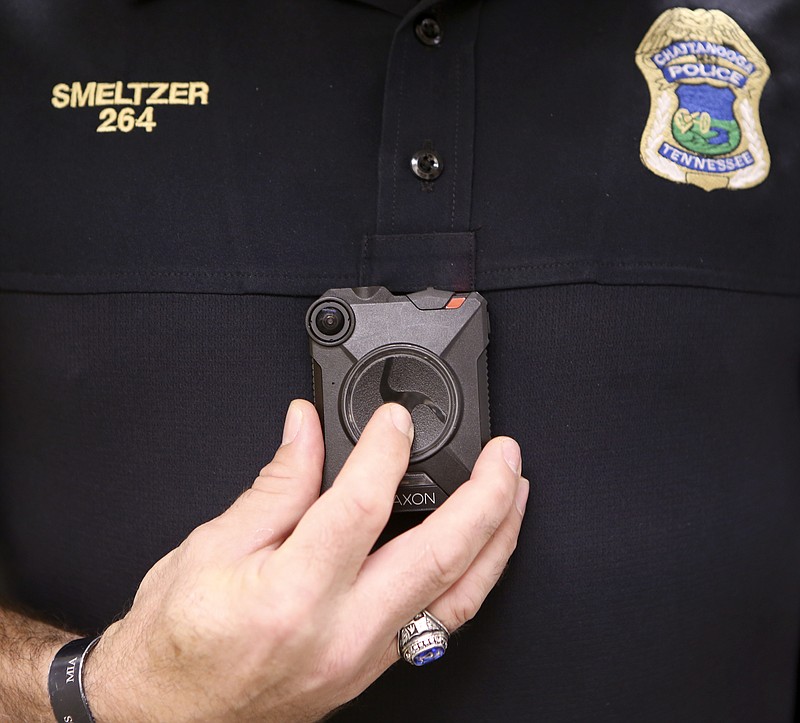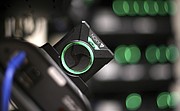Photo Gallery
Coming into focus: Experts say police body cameras aim to change behavior on 'both sides of the badge'
The next time you're pulled over by an officer or have an encounter with police, remember to smile for the camera.
Over the last several months, the Chattanooga Police Department has gradually rolled out its newest equipment - 736 personal body cameras, two for each officer, which will record interactions within the communities they serve.
In December, the Chattanooga City Council voted 9-0 to allow then-police Chief Fred Fletcher to enter into a five-year, $2.2 million contract with a private equipment company to provide the body cameras and storage.
Now several hundred cameras are strapped to the chests of Chattanooga police officers who are using them daily.
"Anytime they're conducting law enforcement action, their cameras should be rolling," said Lt. Mark Smeltzer, who is in charge of the department's body cameras.
He said there are myriad benefits to using the equipment, both for officers and the public. Aside from providing quality evidence to prosecutors or defense attorneys litigating cases, the cameras give the public a window into police encounters.
In the field, cameras can have a de-escalating effect; Smeltzer said people tend to act differently when they know they're being recorded.
"It seems to work. It's kind of an extension of an officer's presence," he said. "If it keeps things to the minimal level of escalation, that's a win-win."
Don Green, executive director of the law enforcement innovation center at the University of Tennessee in Knoxville, agreed with Smeltzer on both counts. He said body cameras, when used properly, protect everyone.
"They provide a deterrent for officer's [sic] acting inappropriately, but also to provide evidence that the officer did indeed act professionally," he wrote in an email. "For the public, during incidents where questionable action has taken place, there is unbiased evidence of what actually occurred."
Concerning the effect cameras have of minimizing escalation during calls, he said everyone is typically on their best behavior when the camera is rolling.
"Officers are aware that their conversations and actions are recorded and as such, are more civil in their interactions and less inclined to overreact when force is necessary," he wrote.
"Complaints are either reduced due to a citizen's being aware that their actions are recorded and as such don't engage the officer in an aggressive manner, or complaints are removed based on being shown the recording," he added.
Smeltzer referenced one incident with an unnamed officer who responded to a report of several men causing a disturbance at night while drinking outside. The officer came to the scene, spoke with the men, they quieted down and that was it.
He said the footage showed a positive interaction between an officer and the public, highlighting another of the equipment's applications - training. Officers can review incidents and learn from what they or others have done before.
"As officers get more and more comfortable with it, they realize it's a tool they can use," he said. "It's got its purpose, just like 15 years ago when we introduced the Taser. Now people just look at it as another tool officers use."
Functionally, the cameras strapped to the chests of Chattanooga officers are fairly straightforward. They are manufactured by Axon and have a 12-hour battery to last an entire shift.
Officers are required to ensure their cameras are working at the beginning of the shift. When it's time to record, they just press a large button on their camera's front. When activated, the camera also includes the 30 seconds of footage collected prior to being activated, which helps ensure proper context.
The department has a policy outlining specific situations when officers are required to activate their cameras, including whenever they "arrive on scene for any call for service" whether dispatched, requested by another officer or self-initiated.
Any failure to follow recording guidelines is subject to review by superiors or the internal affairs office. If an officer delays activating the camera during an incident because he or she was required to act immediately, the manual outlines how the officer must clearly explain the delay in an incident report.
When returning from a shift, officers place the camera in a loading dock, which recharges the camera and offloads all of the footage to a storage facility managed by Axon. At no point do officers or their supervisors have an opportunity to edit or delete footage, and once it has been uploaded, the system notes every time someone watches a recording.
"There is no delete button on those cameras. If you record it, you're stuck with it," said Steve Tuttle, Axon spokesman.
While his company helps police departments store an unlimited amount of footage, employees there also can't edit or delete the material. That protects its evidentiary value in potential cases.
"You have to keep that evidence sacrosanct. It's the agency's evidence," he said.
Body camera footage is subject to public record laws and offers some departmental transparency. Some has led to discipline for officers caught breaking the law. A deputy near Orlando, Fla., resigned earlier this year after his body camera footage appeared to show him taking money out of the wallet of a man he had pulled over for drunken driving.
On the other hand, Tuttle said, videos have vindicated the actions of several officers.
"[Footage has] cleared officers in officer-involved shootings, particularly when there have been no witnesses or witnesses completely disagree with what occurred on the video," he said.
He referred to another incident this year in Baltimore in which an officer shot and killed a man named Curtis Deal. In the officer's body camera footage, Deal can be seen running past the officer with a gun in his hand before turning to aim it at the officer.
Tuttle said the images contradicted statements from witnesses who didn't see the firearm and didn't believe the shooting was justified.
"It completely took away what the so-called witnesses' versions were," he said. "It cleared this officer very quickly. That could have gone sideways."
As more and more officers are equipped with cameras throughout the country, Axon continues to develop new and better devices that could address issues surrounding their use.
The company is actively testing technology that would connect an officer's gun holster and stun gun to the camera. If either is removed from the officer's belt, the body camera and any cameras in the immediate vicinity would all click on.
"These are not magic bullets," he said about the technology and Axon's cameras. "It's not a panacea, but there's nothing better evidentiary wise than video and audio records."
"It's changing behavior on both sides of the badge."
Contact staff writer Emmett Gienapp at egienapp@timesfreepress.com or 423-757-6731. Follow him on Twitter @emmettgienapp.
When are officers required to have their cameras on?
› When arriving on scene for any call for service› When attempting to detain or arrest a person› During any consensual contact in which the officer has a law enforcement purpose› During any investigative stop or encounter involving a member of the public

